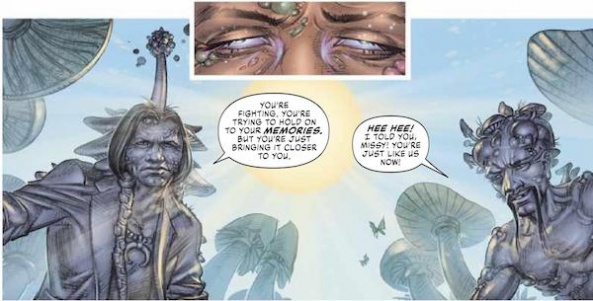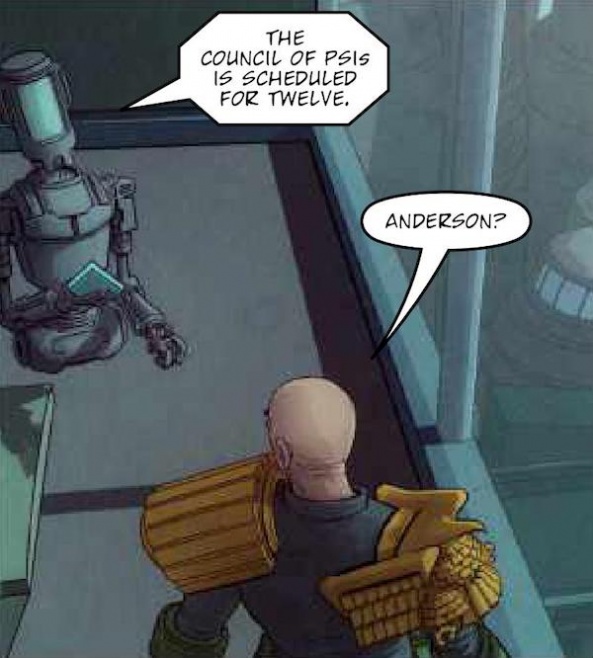
Welcome, Earthlets, to Multiver-City One, our monthly look at the “Judge Dredd Megazine!” Let’s get right to it.


Judge Dredd: Regicide, Part 1
Credits: Arthur Wyatt (Script), Jake Lynch (Art), Jim Boswell (Colors), Annie Parkhouse (Letters)
Christopher Egan: Though listed as the Part One of a new story, this entry works as a new start, but greatly refers to the last strip in Megazine 444. Having been, sorrowfully, left for dead at the ocean floor, Judge Dredd is now trapped amidst the murderous rampage in the underwater facility known as Q-Topia.
Wyatt throws Judge Dredd into this gory, mad-cap, free-for-all battle royale with nothing but his helmet and skivvies to protect him. Of course, Dredd can take care of himself and it’s quite the brutal showing from start to finish as those partaking in a bit of the old ultra-violence are shot, disintegrated, and blown to bits. Overall, it’s a wild and energetic thrill ride, but it may leave those jumping on at this point slightly confused as to how we got here.
Lynch’s artwork is wonderfully detailed and elevates the story nicely. With Boswell on colors, the world of 2000 AD always looks fully realized. We get some cool locations and various styles and set pieces this week.
It’s a wacky and violent “Judge Dredd” adventure that gives us the interesting throughline of an undressed and under-equipped Dredd still being prepared for nearly any situation.

Death Cap, Part 7
Credits: T.C. Eglington (script), Boo Cook (art), Simon Bowland (letters)
Greg Lincoln: T.C. Eglington takes the time and page space to remind us, again, of the now long since dead family of ex-Judge Goya. It was the motivation for her to take this ride of vengeance, so it’s a good place for him to start. She has a flashback and hallucinates their presence in this more than slightly psychedelic story. It would have been more effective if we had more history with her – and them – before their violent death. As it is, that connection still feels a bit too forced. Among all the pastel colored, other worldly, mushroomy landscape, we learn along with her the truth of the mushroom virus and the real plan of the Death Cap Gang. These plot points are really intriguing and somewhat more present than her need for vengeance that drives her. The idea that the mushrooms could potentially cleanse the radiation of the Cursed Earth eventually is deeply cool and sounds oddly plausible, if totally remote. That idea is a bit hard to stomach taken along side the terrible actions being employed by the Death Cap Gang to spread this “cure.” This new twist is more interesting assuredly than the vengeance plot line, but it does feel disconnected from the story’s beginning and focus until now. The last two chapters seem to be taking an odd turn.
Boo Cooks pages this month, like last, pack in a ton of crazy weird images. The mushroom gang, a bit disgusting though they are, are truly wildly interesting to look at. The mutants, the landscape, and all the weird concepts, whether in design or in coloring, show the breadth of Cook’s imagination. The faded pastels jump off the page and sometimes give the feeling of watercolors. The Lawmaster bike, even though it’s a big piece of kit rather than a character, has real impact and presence on the page. “Death Cap” may be a mixed bag of a story, but it’s really fun to look at. As time goes by, it contains more and more interesting bits and ideas to explore, even if it doesn’t stick the landing with all of them.

Diamond Dogs: Book III, Part 7
Credits: James Peaty (script), Warren Pleece (art), Simon Bowland (letters)
Michael Mazzacane: “Diamond Dogs” comes to a surprisingly poignant and poetic end, which is somewhat ironic given how it reflexively points out such lyricism is a falsehood. Nia Jones is no more. It’s time to move on to something new after one last walk through the neighborhood and turning off the lights.
This is a surprising end for a Megazine strip, it’s not so much an end as an epilogue. Just a series of mostly 1–2-page scene of Nia meeting with the remaining cast led by her internal monologue. It’s simple, quiet, and effective. Warren Pleece isn’t given anything to work with besides some remediation as Lau meets his end live on TV. Pleece just puts together a series of strong compositions that are effective. In particular the opening three panels on the third page.
Continued belowFor as poignant and poetic the internal monologue James Peaty rights it is also dripping with the kind of hard boiled cynicism of Dreddverse. Nia is now fully aware of the toxic cycle she is part of and perpetuating and the systems and enablers around her that let it keep happening. One some level she’s freer than she has ever been, aware of the world, but in other ways she is just as trapped. Nia Jones might be over but that also means she’s been reduced to an asset for the international justice department to ship around and do as they please. This keeps an opening for more “Diamond Dog” stories but this is an overall effective ending to the strip as well.

Lawless Ballots over Badrock: 07
Credits: Dan Abnett (script), Phil Winslade (art), Jim Campbell (letters)
Matthew Blair: It’s been a rollercoaster ride in the sleepy colony town of Badrock with a mayoral election, corruption at every level of government, trade relations with aliens, criminal gangs looking to gain a foothold, escaped bio weapons, and newfound vigilante justice. So before we move on, it would certainly make sense for there to be something of a recap to remind old readers of everything that’s going on and get new readers up to speed.
Writer Dan Abnett does a great job of making the recap of “Ballots over Badrock: Part 7” both interesting and informative by having the exposition delivered by a character trying to process everything and talking to their stuffed bear. While the whole thing feels a bit contrived, it’s still interesting and the whole thing feels pretty natural and life-like. It’s fascinating to see everything that has happened to the town laid out in a clear, concise manner and it’s amazing to see just how much things have changed over the past couple of months. Also, while this may be a story that looks to the past, it also does a great job of setting things up for the future as well.
It may appear that Phil Winslade’s art has a slight dip in quality in “Ballots over Badrock: Part 7”, but that’s not necessarily a bad thing. Winslade produced the usual fine detail and realistic proportions that he’s known for, but the whole thing has a grainier feel to it, almost like the audience is viewing the story through a television screen. It’s actually a really clever bit of storytelling through artwork that sets up the twist at the end, which shouldn’t be that surprising to anyone but is still fun to see.
“Ballots over Badrock: Part 7” doesn’t push a whole lot of envelopes or do anything particularly special, but it’s a well written and well drawn mid season recap that is informative, engaging, and quite a bit of fun.

Anderson, PSI Division: Dissolution 01
Credits: Maura McHugh (script), Lee Carter (art), Annie Parkhouse (letters)
Brian Salvatore: Despite the title and the titular character’s presence in this story, ‘Dissolution’ appears to be more of a Judge Shenker story than anything else. This first chapter tells the story of his ascent to head of the PSI Division, with a bookending sequence to bring us into the flashback. The PSI Division is an interesting component of the larger Judge Dredd mythos, and so much of it feels incredibly dissimilar to the other Dredd stories we often get. This story features teleportation, astral projection, and a giant Judge who materializes out of nowhere. While those elements are fun and unexpected, it can also make the tone a little unusual, as the juxtaposition between those elements and the run of the mill paramilitary jargon can give the story a bit of whiplash.
Maura McHugh seems more interested in the concepts than the dialogue, as the story is full of big ideas and stilted speech. Although Judges aren’t exactly the most eloquent characters in comics, this installment feels particularly wooden. That’s added to by Lee Carter’s art, which is similarly stiff. Carter’s art doesn’t flow, and suffers from being posed and blocky, never really coming alive, even when there is action happening, or unusual/interesting events occurring. In general, the chapter reads like storyboards and a first-draft script. The ideas are there, but nothing about the execution inspires much confidence in the strip going forward.






